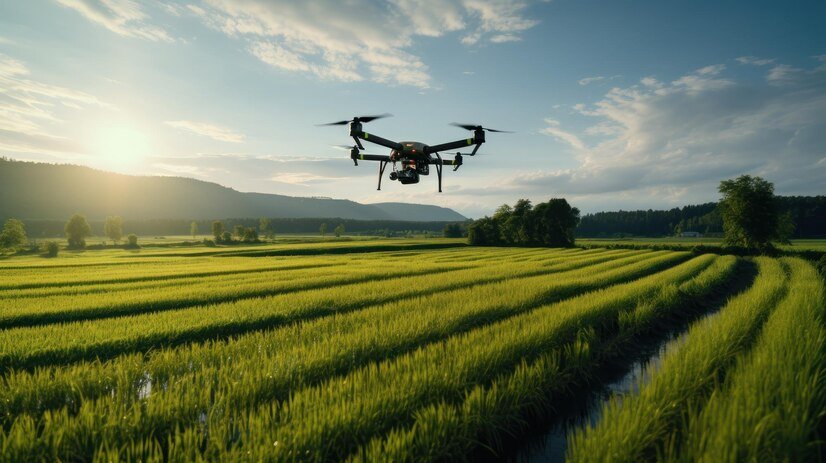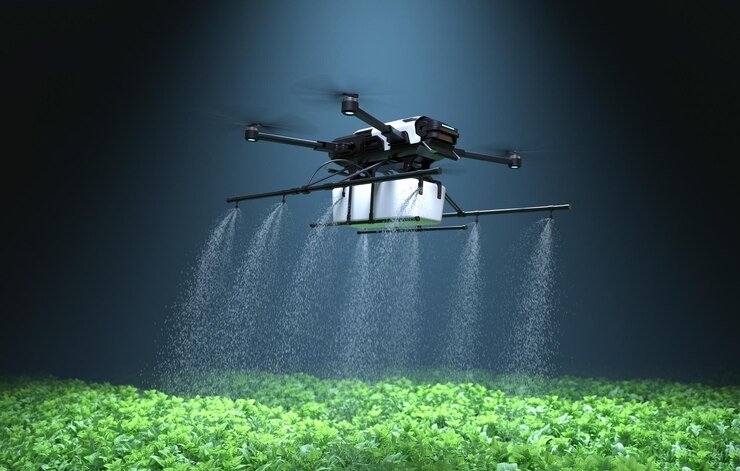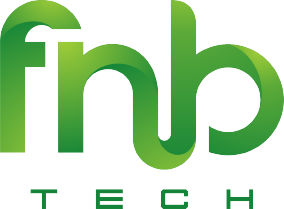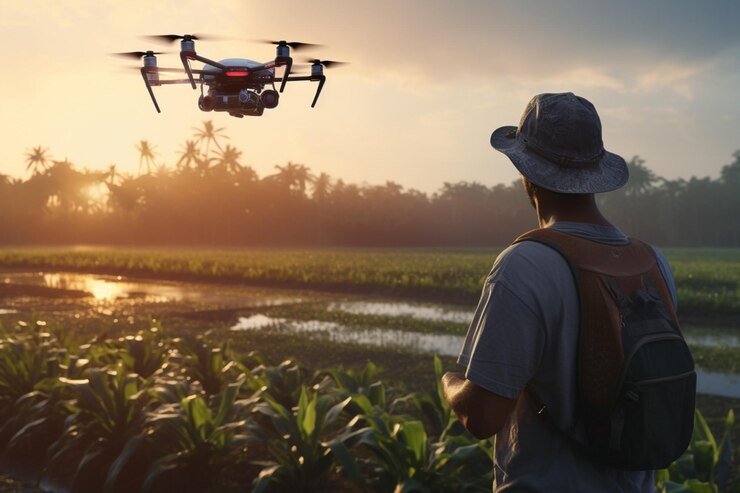The agricultural industry is undergoing a significant transformation as technology becomes more integrated into everyday farming practices. One of the most promising technologies driving this change is UAV drone agriculture.
UAVs, or Unmanned Aerial Vehicles, commonly referred to as drones, are increasingly being utilized to optimize farming practices, improve efficiency, and promote sustainability in agriculture. This article explores the benefits and applications of UAV drone agriculture in the pursuit of sustainable farming.
Read Also: Agricultural Sector Investment Opportunities
Contents
What is UAV Drone Agriculture?

UAV drone agriculture refers to the use of drones equipped with sensors, cameras, and other technologies to assist with various tasks in farming. Drones provide farmers with the ability to monitor crops, assess land conditions, and collect data in real-time.
These aerial vehicles are capable of covering vast areas of land, providing farmers with a bird’s-eye view of their fields. This advanced technology has revolutionized agriculture by offering a more efficient, cost-effective, and sustainable way to manage farms.
The Role of UAV Drone Agriculture in Sustainable Farming
Sustainable farming aims to meet the needs of the present without compromising the ability of future generations to meet their own agricultural needs. As the global population continues to grow, the demand for food rises, and agricultural practices must evolve to increase productivity while minimizing environmental impact.
UAV drone agriculture plays a crucial role in this transition by enabling farmers to adopt more sustainable practices that conserve resources and reduce waste.
1. Precision Agriculture and Resource Efficiency
One of the primary benefits of UAV drone agriculture is its ability to enable precision farming. Precision agriculture refers to the use of technology to manage and optimize field-level farming practices.
Drones equipped with high-resolution cameras and multispectral sensors allow farmers to gather detailed data on soil conditions, crop health, and irrigation needs. By analyzing this data, farmers can apply water, fertilizers, and pesticides more efficiently, reducing waste and minimizing their environmental footprint.
For example, UAVs can detect areas of a field that require more or less water, enabling farmers to use irrigation systems more effectively. This results in significant water savings, which is crucial in regions experiencing water scarcity. Similarly, UAV drone agriculture helps optimize the use of fertilizers, ensuring they are applied only where necessary, reducing excess runoff and pollution.
2. Crop Health Monitoring and Disease Detection
The health of crops is paramount to the success of a farm, and early detection of potential problems is essential for minimizing losses. UAV drone agriculture provides an effective solution for crop health monitoring.
By using drone technology to monitor crops on a regular basis, farmers can detect issues before they become widespread, allowing them to take corrective action quickly. This early intervention can prevent the use of unnecessary pesticides and reduce the impact of chemical treatments on the environment.
3. Improved Soil Health Management
Soil health is a critical component of sustainable farming. Healthy soil supports plant growth, increases water retention, and helps prevent erosion. UAV drone agriculture contributes to better soil management by providing farmers with accurate and timely data about soil conditions across their fields.
Drones can assess soil texture, moisture levels, and compaction. By identifying areas of poor soil health, farmers can take targeted actions to improve those areas, such as adjusting irrigation practices, adding organic matter, or rotating crops. This helps promote soil fertility and structure while reducing the need for chemical fertilizers, which can harm the environment.
4. Enhanced Yield Prediction and Harvesting Efficiency
Accurate yield prediction is essential for farm planning and resource allocation. UAV drone agriculture enhances yield prediction by providing farmers with precise data on crop growth and development.
This information enables farmers to plan their harvesting schedules more effectively, reducing labor costs and minimizing waste. Additionally, drones can assist in monitoring the progress of the harvest, ensuring that crops are collected at the optimal time for maximum yield and quality.
5. Sustainable Pest and Weed Control
The use of chemical pesticides and herbicides in agriculture has raised significant concerns about environmental pollution and biodiversity loss. UAV drone agriculture offers a sustainable alternative by allowing for targeted pest and weed control.
Furthermore, drones can assist in the identification of invasive weed species that may harm crop yields. By targeting specific areas for treatment, farmers can reduce their reliance on broad-spectrum chemical solutions, promoting a healthier and more sustainable farming environment.
Applications of UAV Drone Agriculture

The applications of UAV drone agriculture are vast and continue to expand as technology evolves. From crop monitoring to soil analysis, UAVs are becoming an indispensable tool for modern farmers. Here are some of the key applications of drone Agriculture:
1. Aerial Crop Scouting
Traditional crop scouting involves walking through fields to inspect crops for signs of disease, pests, or nutrient deficiencies. This process can be time-consuming and labor-intensive.
With UAV drone agriculture, farmers can conduct aerial crop scouting, covering large areas of land in a fraction of the time. Equipped with high-resolution cameras and thermal sensors, drones can capture detailed images of crops from above.
2. Irrigation Management
Water management is a critical aspect of sustainable farming. UAVs agriculture helps farmers optimize irrigation practices by providing real-time data on soil moisture levels and crop water needs.
Drones can be used to identify areas of a field that are either over-irrigated or under-irrigated, allowing farmers to adjust their irrigation systems accordingly. By using drones to monitor irrigation systems, farmers can reduce water usage, lower costs, and conserve this valuable resource.
3. Livestock Monitoring
In addition to crop monitoring, UAVs are also being used for livestock management. Drones equipped with cameras and sensors can monitor the health and movement of livestock, ensuring that animals are grazing in the right areas and are free from disease.
UAVs can also assist in locating lost or injured animals, reducing the time and labor required for traditional livestock management.
4. Precision Fertilization
The efficient use of fertilizers is key to reducing environmental impact and maintaining soil health. UAV drone agriculture allows farmers to apply fertilizers precisely where they are needed, based on real-time data gathered from drones.
By using drones for precision fertilization, farmers can minimize fertilizer runoff and improve nutrient uptake by crops.
5. Field Mapping and Analysis
Field mapping is another essential application of UAV drone agriculture. Drones can create detailed maps of farmland, including topography, soil composition, and crop health. These maps can be used for better planning, monitoring, and decision-making, providing farmers with the insights they need to manage their land more efficiently.
Challenges and Limitations of UAV Drone Agriculture
Despite the numerous benefits, there are some challenges and limitations associated with UAV drone agriculture. The cost of purchasing and maintaining drones can be a barrier for small-scale farmers. Additionally, there may be regulatory hurdles regarding drone usage in certain regions, especially related to flight permissions and airspace regulations.
Another limitation is the need for technical expertise. Farmers must be trained to operate drones and analyze the data they collect. While drone technology has become more user-friendly, there is still a learning curve involved for those who are new to the technology.
Join the Future of Sustainable Farming with FnB Tech
As we’ve explored, UAV drone agriculture is revolutionizing the way we approach sustainable farming. The applications of UAV drone technology in agriculture are vast, enabling farmers to monitor crops, detect diseases, and manage their fields with unprecedented accuracy.
At FnB Tech, we are committed to transforming agriculture by integrating the latest technologies, including UAV drones, to drive innovation in farming practices. Our goal is to empower landowners, farmers, and investors worldwide to embrace these groundbreaking solutions for a more efficient, sustainable, and profitable agricultural future.
We invite you to join us on this exciting journey. Whether you are a farmer looking to enhance crop management, a landowner seeking to optimize your farmland, or an investor passionate about the future of agriculture, FnB Tech offers the perfect partnership. Together, we can revolutionize farming through the adoption of UAV drone technology, improving productivity while promoting environmental sustainability.
If you are ready to take the next step in transforming agriculture with UAV drone agriculture, reach out to FnB Agritech today and discover how we can work together to create a smarter, more sustainable future for farming across the globe.
Pippo is passionate about coffee beans, exploring their unique varieties and cultural significance. He has a strong interest in agritech, focusing on innovations that drive sustainable farming. Beyond agriculture, he is also dedicated to the field of aquaculture and its future potential. His curiosity and enthusiasm connect these fields, reflecting a commitment to sustainability and growth.


